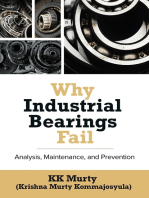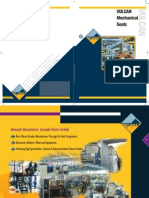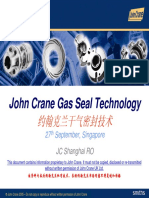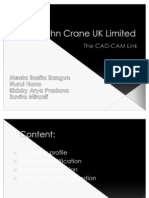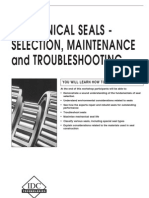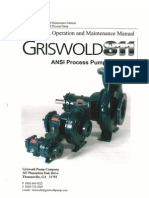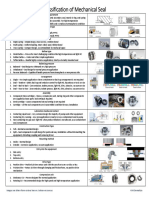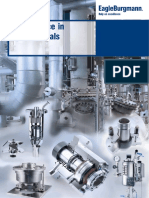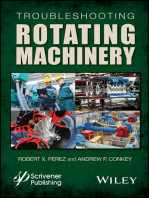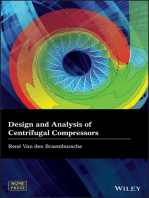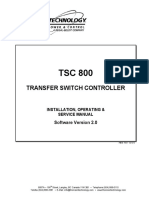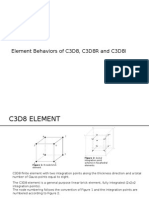Mechanical Seal
Mechanical Seal
Uploaded by
ysudharnnanCopyright:
Available Formats
Mechanical Seal
Mechanical Seal
Uploaded by
ysudharnnanCopyright
Available Formats
Share this document
Did you find this document useful?
Is this content inappropriate?
Copyright:
Available Formats
Mechanical Seal
Mechanical Seal
Uploaded by
ysudharnnanCopyright:
Available Formats
Mechanical Seals A mechanical seal is a sealing device which forms a running seal between rotating and stationary parts.
They were developed to overcome the disadvantages of compression packing. Leakage can be reduced to a level meeting environmental standards of government regulating agencies and maintenance costs can be lower. Advantages of mechanical seals over conventional packing are as follows: 1. 2. 3. 4. 5. 6. Zero or limited leakage of product (meet emission regulations.) Reduced friction and power loss. Elimination of shaft or sleeve wear. Reduced maintenance costs. Ability to seal higher pressures and more corrosive environments. The wide variety of designs allows use of mechanical seals in almost all pump applications.
The Basic Mechanical Seal All mechanical seals are constructed of three basic sets of parts as shown in Fig. 9: 1. A set of primary seal faces: one rotary and one stationary?shown in Fig. 9 as seal ring and insert. 2. A set of secondary seals known as shaft packings and insert mountings such as 0rings, wedges and V-rings. 3. Mechanical seal hardware including gland rings, collars, compression rings, pins, springs and bellows.
Fig. 9 A Simple Mechcanical Seal How A Mechanical Seal Works The primary seal is achieved by two very flat, lapped faces which create a difficult leakage path perpendicular to the shaft. Rubbing contact between these two flat mating surfaces minimizes leakage. As in all seals, one face is held stationary in a housing and the other face is fixed to, and rotates with, the shaft. One of the faces is usually a non-galling material such as carbon-graphite. The other is usually a relatively hard material like silicon-carbide. Dissimilar materials are usually used for the stationary insert and the rotating seal ring face in order to prevent adhesion of the two faces. The softer face usually has the smaller mating surface and is commonly called the wear nose. There are four main sealing points within an end face mechanical seal (Fig. 10). The primary seal is at the seal face, Point A. The leakage path at Point B is blocked by either an 0-ring, a V-ring or a wedge. Leakage paths at Points C and D are blocked by gaskets or 0-rings.
Fig. 10 Sealing Points for Mechanical Seal The faces in a typical mechanical seal are lubricated with a boundary layer of gas or liquid between the faces. In designing seals for the desired leakage, seal life, and energy consumption, the designer must consider how the faces are to be lubricated and select from a number of modes of seal face lubrication. To select the best seal design, it's necessary to know as much as possible about the operating conditions and the product to be sealed. Complete information about the product and environment will allow selection of the best seal for the application. Mechanical Seal Types Mechanical seals can be classified into several tvpes and arrangements:
PUSHER: Incorporate secondary seals that move axially along a shaft or sleeve to maintain contact at the seal faces. This feature compensates for seal face wear and wobble due to misalignment. The pusher seals' advantage is that it's inexpensive and commercially available in a wide range of sizes and configurations. Its disadvantage is that ft's prone to secondary seal hangup and fretting of the shaft or sleeve. Examples are Dura RO and Crane Type 9T.
UNBALANCED: They are inexpensive, leak less, and are more stable when subjected to vibration, misalignment, and cavitation. The disadvantage is their relative low pressure limit. If the closing force exerted on the seal faces exceeds the pressure limit, the lubricating film between the faces is squeezed out and the highly loaded dry running seal fails. Examples are the Dura RO and Crane 9T.
CONVENTIONAL: Examples are the Dura RO and Crane Type 1 which require setting and alignment of the seal (single, double, tandem) on the shaft or sleeve of the pump. Although setting a mechanical seal is relatively simple, today's emphasis on reducing maintenance costs has increased preference for cartridge seals.
NON-PUSHER: The non-pusher or bellows seal does not have to move along the shaft or sleeve to maintain seal face contact, The main advantages are its ability to handle high and low temperature applications, and does not require a secondary seal (not prone to secondary seal hang-up). A disadvantage of this style seal is that its thin bellows cross sections must be upgraded for use in corrosive environments Examples are Dura CBR and Crane 215, and Sealol 680.
BALANCED: Balancing a mechanical seal involves a simple design change, which reduces the hydraulic forces acting to close the seal faces. Balanced seals have higher-pressure limits, lower seal face loading, and generate less heat. This makes them well suited to handle liquids with poor lubricity and high vapor pressures such as light hydrocarbons. Examples are Dura CBR and PBR and Crane 98T and 215.
CARTRIDGE: Examples are Dura P-SO and Crane 1100 which have the mechanical seal premounted on a sleeve including the gland and fit directly over the Model 3196 shaft or shaft sleeve (available single, double, tandem). The major benefit, of course is no requirement for the usual seal setting measurements for their installation. Cartridge seals lower maintenance costs and reduce seal setting errors
Mechanical Seal Arrangements SINGLE INSIDE: This is the most common type of mechanical seal. These seals are easily modified to accommodate seal flush plans and can be balanced to withstand high seal environment pressures. Recommended for relatively clear non-corrosive and corrosive liquids with satisfactory' lubricating properties where cost of operation does not exceed that of a double seal. Examples are Dura RO and CBR and Crane 9T and 215. Reference Conventional Seal. SINGLE OUTSIDE: If an extremely corrosive liquid has good lubricating properties, an outside seal offers an economical alternative to the expensive metal required for an inside seal to resist corrosion. The disadvantage is that it is exposed outside of the pump which makes it vulnerable to
damage from impact and hydraulic pressure works to open the seal faces so they have low pressure limits (balanced or unbalanced).
DOUBLE (DUAL PRESSURIZED): This arrangement is recommended for liquids that are not compatible with a single mechanical seal (i.e. liquids that are toxic, hazardous [regulated by the EPA], have suspended abrasives, or corrosives which require costly materials). The advantages of the double seal are that it can have five times the life of a single seal in severe environments. Also, the metal inner seal parts are never exposed to the liquid product being pumped, so viscous, abrasive, or thermosetting liquids are easily sealed without a need for expensive metallurgy. In addition, recent testing has shown that double seal life is virtually unaffected by process upset conditions during pump operation. A significant advantage of using a double seal over a single seal. The final decision between choosing a double or single seal comes down to the initial cost to purchase the seal, cost of operation of the seal, and environmental and user plant emission standards for leakage from seals. Examples are Dura double RO and X-200 and Crane double 811T.
DOUBLE GAS BARRIER (PRESSURIZED DUAL GAS): Very similar to cartridge double seals ... sealing involves an inert gas, like nitrogen, to act as a surface lubricant and coolant in place of a liquid barrier system or external flush required with conventional or cartridge double seals. This concept was developed because many barrier fluids commonly used with double seals can no longer be used due to new emission regulations. The gas barrier seal uses nitrogen or air as a harmless and inexpensive barrier fluid that helps prevent product emissions to the atmosphere and fully complies with emission regulations. The double gas barrier seal should be considered for use on toxic or hazardous liquids that are regulated or in situations where increased reliability is the required on an application. Examples are Dura GB2OO, GF2OO, and Crane 2800.
TANDEM (DUAL UNPRESSURIZED): Due to health, safety, and environmental considerations, tandem seals have been used for products such as vinyl chloride, carbon monoxide, light hydrocarbons, and a wide range of other volatile, toxic, carcinogenic, or hazardous liquids.
You might also like
- En 10263-2 2001Document7 pagesEn 10263-2 2001Luca TurraNo ratings yet
- Mechanical SealDocument127 pagesMechanical SealVivek Rathod86% (22)
- Improving Mechanical Seal ReliabilityDocument4 pagesImproving Mechanical Seal ReliabilityBala MuruganNo ratings yet
- Operator’S Guide to Rotating Equipment: An Introduction to Rotating Equipment Construction, Operating Principles, Troubleshooting, and Best PracticesFrom EverandOperator’S Guide to Rotating Equipment: An Introduction to Rotating Equipment Construction, Operating Principles, Troubleshooting, and Best PracticesRating: 5 out of 5 stars5/5 (3)
- A Comparative Study On Sound Transmission Loss and Absorption Coefficient of Acoustical Materials PDFDocument13 pagesA Comparative Study On Sound Transmission Loss and Absorption Coefficient of Acoustical Materials PDFHo Zhen MengNo ratings yet
- Mar14 PDFDocument2 pagesMar14 PDFsudhindra_tiwariNo ratings yet
- Why Industrial Bearings Fail: Analysis, Maintenance, and PreventionFrom EverandWhy Industrial Bearings Fail: Analysis, Maintenance, and PreventionNo ratings yet
- Mechanical SealsDocument3 pagesMechanical Sealsapi-3848429100% (2)
- Why Mech Seal FailDocument5 pagesWhy Mech Seal FailMunam AhmedNo ratings yet
- Mechanical SealsDocument54 pagesMechanical Sealsajitkk79100% (2)
- Vulcam Mechanical SealsDocument122 pagesVulcam Mechanical SealsRicardoDoPradoNo ratings yet
- 100 Mechanical Seals PresentationDocument81 pages100 Mechanical Seals PresentationMahesh KumarNo ratings yet
- Single Spring Mechanical SealsDocument72 pagesSingle Spring Mechanical Sealsconwaymatty100% (1)
- 4 Ways To Prevent Seal FailureDocument5 pages4 Ways To Prevent Seal FailureGlobe Star Engineers Pvt LtdNo ratings yet
- Pump Motor TripDocument4 pagesPump Motor TripKamal Uddin100% (1)
- Installing A Mechanical Seal 1Document9 pagesInstalling A Mechanical Seal 1ZakNo ratings yet
- Mechanical SealsDocument49 pagesMechanical Sealsnaga_raj_19100% (1)
- Mechanical SealsDocument107 pagesMechanical Sealsseaqu3st100% (2)
- 1 - SealbasicsDocument72 pages1 - SealbasicsdhasdjNo ratings yet
- ISOMAG - Pump - Zone - Reprint-Bearing Protection DevicesDocument5 pagesISOMAG - Pump - Zone - Reprint-Bearing Protection DevicesChandra SimanjuntakNo ratings yet
- Fitting InstructionDocument6 pagesFitting InstructionAan Sarkasi AmdNo ratings yet
- Calculating Stuffing Box PressuresDocument2 pagesCalculating Stuffing Box PressuresSuresh Kumar MittapalliNo ratings yet
- Prepared By: PESB Technical Service Department (2019)Document60 pagesPrepared By: PESB Technical Service Department (2019)ASY178100% (4)
- EagleBurgmann - API682 4th Facts, Innovations, SolutionsDocument26 pagesEagleBurgmann - API682 4th Facts, Innovations, SolutionsTasawwur Tahir100% (1)
- John Crane Gas Seal Technology: 27 September, SingaporeDocument44 pagesJohn Crane Gas Seal Technology: 27 September, SingaporeLiu ZhongtaiNo ratings yet
- 5 Day Combined Mechanical Seals Dry Gas Seals Course 2013Document5 pages5 Day Combined Mechanical Seals Dry Gas Seals Course 2013Siddiqui Abdul KhaliqNo ratings yet
- Mechanical Seal Principles Manual - Chapter 1Document28 pagesMechanical Seal Principles Manual - Chapter 1avciayNo ratings yet
- Mechanical SealDocument50 pagesMechanical SealKaler Soto Peralta100% (1)
- 100 Mechanical SealsDocument20 pages100 Mechanical SealsDeepa VpNo ratings yet
- Mechanical Seal-Part One PDFDocument193 pagesMechanical Seal-Part One PDFusmaniqbal15No ratings yet
- Mechanical Seal Applications A Comprehensive ReportDocument2 pagesMechanical Seal Applications A Comprehensive Reportvarunzhao86No ratings yet
- Mechanical Seal Face MaterialsDocument19 pagesMechanical Seal Face MaterialsKamlesh Kamlesh Etwaro100% (1)
- John CraneDocument16 pagesJohn CraneMenta Basita Bangun100% (1)
- Double Mechanical Seals, Tandem ArrangementDocument10 pagesDouble Mechanical Seals, Tandem ArrangementViwek MertiyaNo ratings yet
- Mechanical SealsDocument2 pagesMechanical Sealscuraaj100% (1)
- Manual Griswold Model 811Document54 pagesManual Griswold Model 811Naranjo MarinoNo ratings yet
- Mechanical Seal Failure Troubleshooting Guide: Bell & Gossett Centrifugal PumpsDocument18 pagesMechanical Seal Failure Troubleshooting Guide: Bell & Gossett Centrifugal Pumpsmasterplumber100% (2)
- PRESENTATION ON MECHANICAL SEALS 20160110 (Compatibility Mode) PDFDocument130 pagesPRESENTATION ON MECHANICAL SEALS 20160110 (Compatibility Mode) PDFAnonymous q9eCZHMuS100% (1)
- Fluiten Plan APIDocument71 pagesFluiten Plan APImontsegran100% (1)
- Mechanical Seal ClassificationsDocument1 pageMechanical Seal ClassificationsAkshayGuptaNo ratings yet
- Materials Compatibility enDocument9 pagesMaterials Compatibility enismb_isaacNo ratings yet
- Up-Stream Pumping - Presentation1Document46 pagesUp-Stream Pumping - Presentation1Chozha RajanNo ratings yet
- Seal Troubleshooting - EnglishDocument24 pagesSeal Troubleshooting - EnglishGerson Salinas100% (1)
- Aes Api682 01Document9 pagesAes Api682 01meghanahari100% (1)
- Cartridge Seals - TE - April - 12 PDFDocument34 pagesCartridge Seals - TE - April - 12 PDFleoNo ratings yet
- EagleBurgmann - Competence in Agitator Seals - 2017Document42 pagesEagleBurgmann - Competence in Agitator Seals - 2017munhNo ratings yet
- Vertical Sump PumpDocument6 pagesVertical Sump Pumpsahildhingra100% (1)
- 3-Day Gen Open 112003 1a (Compatibility Mode)Document84 pages3-Day Gen Open 112003 1a (Compatibility Mode)api-3703348100% (2)
- API Mechanical Seal Flushing Plan Part 1Document11 pagesAPI Mechanical Seal Flushing Plan Part 1Dhanraj BaroleNo ratings yet
- Mechanical Seals: The BasicsDocument2 pagesMechanical Seals: The Basicssyed_Pro07No ratings yet
- Mechanical Seal Application (Eagleburgmann)Document30 pagesMechanical Seal Application (Eagleburgmann)Jai-Hong ChungNo ratings yet
- Troubleshooting Rotating Machinery: Including Centrifugal Pumps and Compressors, Reciprocating Pumps and Compressors, Fans, Steam Turbines, Electric Motors, and MoreFrom EverandTroubleshooting Rotating Machinery: Including Centrifugal Pumps and Compressors, Reciprocating Pumps and Compressors, Fans, Steam Turbines, Electric Motors, and MoreNo ratings yet
- Pump Wisdom: Problem Solving for Operators and SpecialistsFrom EverandPump Wisdom: Problem Solving for Operators and SpecialistsRating: 1 out of 5 stars1/5 (1)
- Analytical Troubleshooting of Process Machinery and Pressure Vessels: Including Real-World Case StudiesFrom EverandAnalytical Troubleshooting of Process Machinery and Pressure Vessels: Including Real-World Case StudiesRating: 3 out of 5 stars3/5 (1)
- Steam Turbines A Book of Instruction for the Adjustment and Operation of the Principal Types of this Class of Prime MoversFrom EverandSteam Turbines A Book of Instruction for the Adjustment and Operation of the Principal Types of this Class of Prime MoversRating: 5 out of 5 stars5/5 (2)
- Operator’S Guide to Centrifugal Pumps: What Every Reliability-Minded Operator Needs to KnowFrom EverandOperator’S Guide to Centrifugal Pumps: What Every Reliability-Minded Operator Needs to KnowRating: 2 out of 5 stars2/5 (1)
- DryGasSealsDocument6 pagesDryGasSealsNoman Abu-FarhaNo ratings yet
- Hydro-Turbine Main Shaft Axial Seals ofDocument13 pagesHydro-Turbine Main Shaft Axial Seals ofAnonymous Hy5Ir9QXNo ratings yet
- PP9a - Solutions - Trusses - Method of JointsDocument8 pagesPP9a - Solutions - Trusses - Method of JointsDamirAljosevicNo ratings yet
- 10 Common Problems in Energy Audits: Technical FeatureDocument5 pages10 Common Problems in Energy Audits: Technical FeaturehemanthbolemNo ratings yet
- Flat Slab ExcelDocument50 pagesFlat Slab ExcelJEFFY JACOB100% (1)
- Curriclam Vitae Raju KCDocument5 pagesCurriclam Vitae Raju KCRaju K.C.No ratings yet
- TSC800 PM049R7Document85 pagesTSC800 PM049R7ANDRE LUIZ RAMOS DE FREITASNo ratings yet
- Technical Data Sheet For Hilti HIT HY 200Document39 pagesTechnical Data Sheet For Hilti HIT HY 200ValeriuNo ratings yet
- Nioec SP 50 59Document9 pagesNioec SP 50 59aminNo ratings yet
- D. V. Bompa and A. Y. Elghazouli, 2020. Experimental and Numerical Assessment of The Shear Behaviour of Lime Mortar Clay Brick Masonry TripletsDocument17 pagesD. V. Bompa and A. Y. Elghazouli, 2020. Experimental and Numerical Assessment of The Shear Behaviour of Lime Mortar Clay Brick Masonry TripletsMichael PisfilNo ratings yet
- DOS - Steel Bridge - Lecture 4 PDFDocument9 pagesDOS - Steel Bridge - Lecture 4 PDFM Sajjad TufailNo ratings yet
- KT 230045 DN Roka JeddahDocument12 pagesKT 230045 DN Roka JeddahUsman AwaisNo ratings yet
- BASOR Catalogue B02Document317 pagesBASOR Catalogue B02Zagoni-Szabo Jozsef-CsabaNo ratings yet
- Subject: AHU& FCU Connection Details Project: NHJH AHU Connection and Access Side Based On Below Picture For ReferencesDocument3 pagesSubject: AHU& FCU Connection Details Project: NHJH AHU Connection and Access Side Based On Below Picture For ReferencesAHMED ATIFNo ratings yet
- 4 Cracking of Concrete - ACI and CEB ApproachesDocument40 pages4 Cracking of Concrete - ACI and CEB ApproachesisenefretNo ratings yet
- 300+ TOP CABLES Objective Type Questions and Answers Electrical Engineering Multiple Choice QuestionsDocument16 pages300+ TOP CABLES Objective Type Questions and Answers Electrical Engineering Multiple Choice QuestionsNaveedNo ratings yet
- Operation and Maintenance of Hydro Tunnels 13th December 2018 Kathmandu, NepalDocument28 pagesOperation and Maintenance of Hydro Tunnels 13th December 2018 Kathmandu, NepalAbhushan NeupaneNo ratings yet
- c3d8 SandyDocument17 pagesc3d8 Sandyvinay_anand2No ratings yet
- FabrioptionsDocument16 pagesFabrioptionsniyiv44079No ratings yet
- 62 60599 01Document44 pages62 60599 01HoussemTunisinoNo ratings yet
- ORDER FORM: F (B) - 3500 Insertion Mag Flow Meters: Application & Configuration DataDocument4 pagesORDER FORM: F (B) - 3500 Insertion Mag Flow Meters: Application & Configuration DataOctavio BarbozaNo ratings yet
- Construction and Design Defects in The Residential Buildings and Observed Earthquake Damage Types in TurkeyDocument15 pagesConstruction and Design Defects in The Residential Buildings and Observed Earthquake Damage Types in Turkeyjihan TariNo ratings yet
- Vistamaxx Processing Guidelines Meltblown Fabrics PDFDocument2 pagesVistamaxx Processing Guidelines Meltblown Fabrics PDFA MahmoodNo ratings yet
- Doe Condition Assessment - Work Breakdown Structure Uniformat IiDocument1 pageDoe Condition Assessment - Work Breakdown Structure Uniformat Iiscribd_spiceNo ratings yet
- AcknowledgementDocument4 pagesAcknowledgementEndalkachew AddisNo ratings yet
- 002 - Preliminary SectionsDocument17 pages002 - Preliminary SectionssamNo ratings yet
- Sustainable Design, Construction and Operation of A Residential High-Rise Building in San Francisco PDFDocument105 pagesSustainable Design, Construction and Operation of A Residential High-Rise Building in San Francisco PDFFrancisco Bustos-GonzálezNo ratings yet
- Ijebu Mushin Capital Projects 2022 - UnpricedDocument68 pagesIjebu Mushin Capital Projects 2022 - Unpricedoseni momoduNo ratings yet
- Seminar On Material ScienceDocument16 pagesSeminar On Material ScienceLucifuge RofocaleNo ratings yet
- Din 571 Vairados PDFDocument4 pagesDin 571 Vairados PDFmugiwara ruffyNo ratings yet







